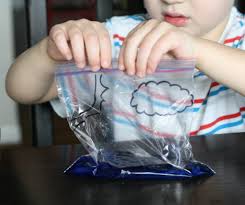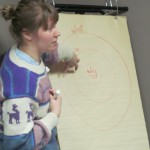It’s finally spring! Soon you will notice an increase in the amount of precipitation, mainly in the form of rain. On days where it might seem like the rain won’t stop, your little ones might ask, “Why does it rain?” and “Where does the rain come from?” In this edition of Let’s Discover, we will explore how the water cycle works.
Before we start, get a glass of cold water and put it on the table. Take a good long look at the water; can you guess how old it is? The water in your glass may have fallen from the sky as rain just last week. But water has been here since the birth of our planet. Can you believe that when the first fish crawled out of the ocean onto land, your glass of water was part of that ocean? Or when the Brontosaurus walked through lakes feeding on plants, your glass of water was a part of those lakes. Even when kings and princesses, knights and squires took a drink from their wells, your glass of water was a part of those too. For over four billion years, water has been recycled around the earth!
The Earth has a limited amount of water. That water keeps going around and around and around and around and (well, you get the idea) in what we call the “Water Cycle”.
This cycle is made up of four main parts:
Evaporation – Evaporation happens when the sun heats up water in rivers, lakes and the ocean and turns it into vapour (gaseous state). The water vapour leaves the river, lake or ocean and goes into the air. Like us, plants sweat too. Well, sort of…. people perspire (sweat) and plants transpire. When we talk about plants transpiring, this is when the moisture is carried through the plant from its roots to the small pores on the underside of plant leaves, where it changes to vapour and is released to the atmosphere (air). Therefore, transpiring or rather transpiration is another form of evaporation.
Condensation – When water vapour in the atmosphere gets cold, it changes from a gas back into a liquid. This is called condensation. Condensation is actually the cause of cloud formation in the atmosphere. You can also see the same sort of thing happen at home. When you pour a glass of cold water on a hot day and watch what happens you’ll see that water forms on the outside of the glass. Now, that water didn’t somehow leak through the glass, right? Of course not, it actually came from the air. When water vapour in the warm air touches the cold glass it turns back into a liquid.
Precipitation – Precipitation occurs when so much water has condensed that the air cannot hold it anymore. Therefore, the clouds get too heavy to hold the water, and it falls back to the Earth in the form of rain, hail, sleet or snow.
Collection – When water falls back to the Earth as precipitation, it may fall back into a body of water, or on land. When it ends up on land, it will either soak into the Earth or become part of the “ground water” that plants and animals drink or it run over the soil and collect in the oceans, lakes or rivers where the cycle starts all over again.
In this month’s Let’s Discover experiment, we will create our own simulation of the water cycle using a Ziploc bag, a window and a glass of water. Here’s what you’ll need to get started:
Materials
Ziploc bag
Small clear plastic cup
Permanent marker
Tape
Food colouring
Water
Procedure:
- Collect your supplies.
- On your Ziploc bag, draw a line across the bottom with your permanent marker parallel to the bottom of the bag to represent the ocean or a lake.
- In the top left hand corner, draw a sun with your permanent marker.
- At the top of the bag, to the right of the sun, draw a cloud. These images represent a few of the factors involved in the water cycle.
- Fill your small clear plastic cup ¾ full of water. Add a few drop of food coloring.
- Carefully place the cup in the bottom of your bag and seal the Ziploc bag.
- Using a strong tape (such as duct tape) tape the Ziploc bag on a sunny window (south facing) or by a heat source.
- Leave the cup overnight and observe in the morning.
- Observe the Ziploc bag everyday for a few days.
Questions
- What caused the water to evaporate?
- How do you know the water evaporated?
- How are clouds formed?
- Why does the water end up outside the cup?
Water is one of the most essential elements we have on our planet and helps all living things from plants, animals and us! Keep learning more about water and the importance of conserving our water supply for generations to come. And stay tuned for Discovery Centre’s next Featured Exhibit coming in May, it’s all about water!
For more great things to discover – visit the Discovery Centre on Barrington Street in Halifax, check out their website or join them on facebook.




